You may develop tiny red spots on your skin for many different reasons. Some of these underlying causes may be quite serious, while others may not raise any concern. It is, however, important to understand when you should go see your doctor and seek medical treatment. Keep reading to learn more.
What Are the Possible Causes of Tiny Red Dots on Skin?
1. "Red Mole" or Cherry Angiomas
Cherry angiomas are quite common and can appear on any area of your body. Also known as senile angiomas, they usually affect people over 30 years of age. They look red because of broken blood vessels inside them.
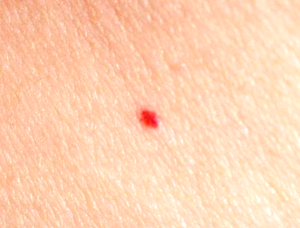 While the exact cause of these skin growths is not clear, many experts believe it has something to do with genetics. Some people are more likely to get them compared to others. They are more likely to appear in pregnancy and are even linked to climate and exposure to chemicals. You do not usually need to worry about these skin growths unless you notice a change in their shape, size, or color. Talk to your doctor if they bleed often.
While the exact cause of these skin growths is not clear, many experts believe it has something to do with genetics. Some people are more likely to get them compared to others. They are more likely to appear in pregnancy and are even linked to climate and exposure to chemicals. You do not usually need to worry about these skin growths unless you notice a change in their shape, size, or color. Talk to your doctor if they bleed often.
2. Petechiae
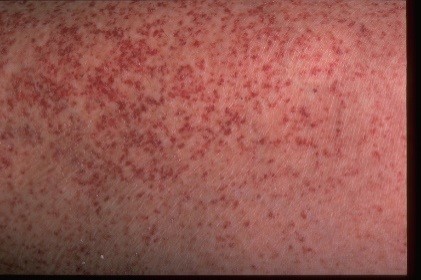 If you notice pinpoint, round, tiny red dots on skin, they could be petechiae. These growths develop as a result of bleeding, and this is the reason why they may look brown, red, or purple. They look more like a rash and appear in clusters. The color remains the same even when you press on them. And they may appear on your eyelids or on the inner surface of your mouth.
If you notice pinpoint, round, tiny red dots on skin, they could be petechiae. These growths develop as a result of bleeding, and this is the reason why they may look brown, red, or purple. They look more like a rash and appear in clusters. The color remains the same even when you press on them. And they may appear on your eyelids or on the inner surface of your mouth.
Causes: While petechiae are quite common, they may indicate different conditions. The most common causes include allergic reaction, local injury, autoimmune diseases, trauma, and viral infections that impair clotting. Certain medical treatments such as chemotherapy and radiation, as well as leukemia, idiopathic thrombocytopenic purpura, and other bone marrow malignancies can also cause petechiae to appear. Drugs such as aspiring, heparin, or cortisone may also cause petechiae. They are more common in newborns and become prominent after violent vomiting.
Treatment: Antibiotics are prescribed in case of an infection causing petechiae formation and appearance. If these petechiea spots are the consequence of injuries to the blood capillaries, apply ice packs or cold compressions over the affected region. It is suggested that before applying ice, a paper towel should be put between your skin and the ice pack. This will prevent damage to the skin surface.
3. Keratosis Pilaris
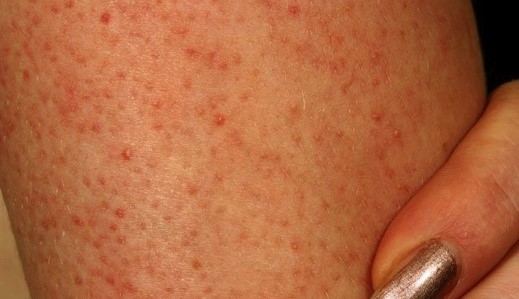 Keratosis pilaris (KP) also causes small red spots on your skin. This genetic disorder affects hair follicles of the skin and often manifests as rough, small folliculocentric keratotic papules. They are also described as chicken skin, chicken bumps, or goose bumps and usually appear on the outer-upper highs and arms.
Keratosis pilaris (KP) also causes small red spots on your skin. This genetic disorder affects hair follicles of the skin and often manifests as rough, small folliculocentric keratotic papules. They are also described as chicken skin, chicken bumps, or goose bumps and usually appear on the outer-upper highs and arms.
The condition usually gets better in summer months and becomes worse in winter when skin becomes dry. KP is self-limited and usually improves with age. There is no treatment available for it, but you may use moisturizing lotions and creams to make things feel better.
4. Leukocytoclastic Vasculitis
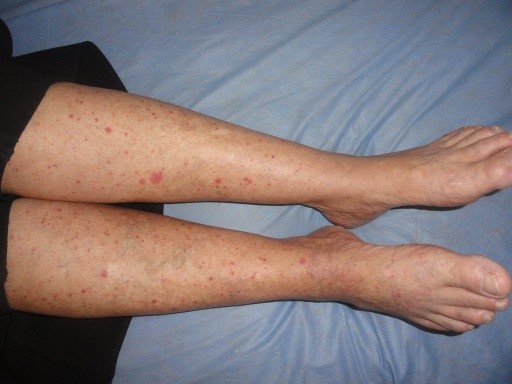 Leukocytoclastic vasculitis or commonly known as hypersensitivity vasculitis refers to the inflammation of small blood vessels. Leukocytoclastic is a term used to refer to the debris of immune cells or neutrophils within the walls of blood vessels. The disease may only affect your skin or spread to other organs of the body, including central nervous system, gastrointestinal tract, heart, lungs, and the kidneys.
Leukocytoclastic vasculitis or commonly known as hypersensitivity vasculitis refers to the inflammation of small blood vessels. Leukocytoclastic is a term used to refer to the debris of immune cells or neutrophils within the walls of blood vessels. The disease may only affect your skin or spread to other organs of the body, including central nervous system, gastrointestinal tract, heart, lungs, and the kidneys.
Symptoms: When it affects your skin, you notice damaged blood vessels that become leaky. It results in hemorrhage that appears as small areas of purple-red, raised lesions or tiny red dots, also called palpable purpura. These lesions are most commonly found on the legs. They generally do not cause any symptom, but you may sometimes feel pain and itching. More severe vessel inflammation may result in large ulcerated blisters that can be quite painful. They may make you deal with other issues, including vomiting, abdominal pain, muscle aches, fever, blood in the urine, weakness, numbness, and cough.
Treatment: Your doctor will consider your medical history before determining the best treatment option for leukocytoclastic vasculitis. If you experienced a single occurrence of tiny red dots on skin, this is an acute case. The lesion diminishes in this case after removing drug, infection, or food that may be causing the problem. In recurrent or chronic cases, your doctor will consider several other factors to select a treatment option. They may ask for tests to help identify an underlying systemic disease. They may also give corticosteroids and immunosuppressive agents in case the disease has spread to your internal organs. Medications such as dapsone and colchicines may help treat chronic cases.
5. Rheumatic Fever
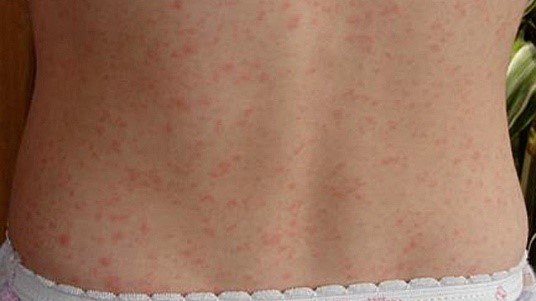 Not seeking treatment for strep throat in a timely manner may result in rheumatic fever. It usually affects children from 5 and 15 years of age. Older children and adults may also contract the fever. It is not a serious illness and when left untreated, it may cause serious issues including permanent damage to your heart, stroke, and death.
Not seeking treatment for strep throat in a timely manner may result in rheumatic fever. It usually affects children from 5 and 15 years of age. Older children and adults may also contract the fever. It is not a serious illness and when left untreated, it may cause serious issues including permanent damage to your heart, stroke, and death.
As it is a complication of strep throat, you should go for a strep test if your child has certain specific symptoms, such as sore throat with swollen lymph nodes and tiny red dots on skin. They may also have trouble swallowing with thick, blood discharge from nose.
Once the doctor confirms that your child has rheumatic fever, they may decide to use one of the following treatment options:
- Antibiotics will be prescribed to help treat the infection and may also prescribe a long-term treatment to avoid reoccurrence.
- Anti-inflammatory medications will be used to deal with pain. The most common choices are naproxen and aspirin. Some healthcare providers may also use corticosteroids to reduce inflammation.
- Your child may need to take anticonvulsant medications for some time if involuntary movements are causing serious problems.
In addition, your child needs to take plenty of rest until pain and inflammation go away completely. It is important to ensure rest for a few weeks at least if the fever causes heart problems.
